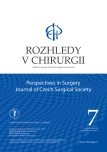Fournier‘s gangrene as Amyand‘s hernia complication
Authors:
F. Sládek 1; V. Krass 1,2; O. Salaš 1; M. Sutorý 1,2; L. Paša 2
Authors place of work:
Chirurgické oddělení, Úrazová nemocnice v Brně
1; Klinika traumatologie Lékařské fakulty Masarykovy Univerzity Brno
2
Published in the journal:
Rozhl. Chir., 2019, roč. 98, č. 7, s. 291-296.
Category:
Kazuistika
Summary
Introduction: Fournier’s gangrene is a rare but fast deteriorating and serious condition with high mortality. In most cases, it is characterized as necrotizing fasciitis of the perineum and external genitals. Amyand’s hernia is a rare condition where the appendix is contained in the sac of an inguinal hernia. Inflammatory alterations in the appendix account only for 0.1 % of the cases when Amyand’s hernia is verified. Fournier’s gangrene as a complication of a late diagnosis of appendicitis located in the inguinal canal is described in the literature as rare case reports.
Case report: The case report of a 70-year-old patient with Fournier’s gangrene resulting from gangrenous appendicitis of Amyand’s hernia.
Conclusion: Fournier’s gangrene as a complication of Amyand’s hernia is a rare condition. Only sporadic case reports thereof can be found in the literature. Because of the rarity of this pathology and the lack of randomized controlled studies, it is difficult to determine the optimal treatment according to the principles of evidence-based medicine. An appropriate approach for this condition appears to be the combination of guidelines developed in Amyand’s therapy according to Losanoff and Basson, along with the recommended “gold standard” therapy for Fournier’s gangrene. This means early and highly radical surgical debridement, adequate antibiotic therapy and intensive care.
Keywords:
inguinal hernia – Fournier’s gangrene – Amyand’s hernia – necrotizing fasciitis – gangrenous appendicitis
Zdroje
- Yanar H, Taviloglu K, Ertekin C, et al. Fournier’s gangrene: risk factors and strategies for management. World J Surg. 2006;30:1750–4. doi:10.1007/s00268-005-0777-3.
- Fournier JA. Jean-Alfred Fournier 1832-1914. Gangrène foudroyante de la verge (overwhelming gangrene). Sem Med 1883. Dis Colon Rectum. 1988;31:984–8.
- Pernetti R, Palmieri F, Sagrini E, et al. Fournier’s gangrene: Clinical case and review of the literature. Arch Ital Urol Androl Organo Uff Soc Ital Ecogr Urol E Nefrol. 2016;88:237–8. doi:10.4081/aiua.2016.3.237.
- Singh A, Ahmed K, Aydin A, et al. Fournier’s gangrene. A clinical review. Arch Ital Urol Androl Organo Uff Soc Ital Ecogr Urol E Nefrol. 2016;88:157–64.
- Eke N. Fournier’s gangrene: a review of 1726 cases. Br J Surg. 2000;87:718–28. doi: 10.1046/j.1365-2168.2000.01497.x.
- Amyand C. Of an inguinal rupture, with a pin in the appendix coeci, incrusted with stone; and some observations on wounds in the guts. Phil Trans R Soc. 1736;39:329–42.
- Creese PG. The first appendectomy. Surg Gynecol Obstet. 1953;97:643–52.
- Michalinos A, Moris D, Vernadakis S. Amyand’s hernia: a review. Am J Surg. 2014;207:989–95. doi: 10.1016/j.amjsurg.2013.07.043.
- Gupta S, Sharma R, Kaushik R. Left-sided Amyand’s hernia. Singapore Med J. 2005;46:424–5.
- Losanoff JE, Basson MD. Amyand hernia: a classification to improve management. Hernia 2008;12:325–6. doi: 10.1007/s10029-008-0331-y.
- Sharma H, Gupta A, Shekhawat NS, et al. Amyand’s hernia: a report of 18 consecutive patients over a 15-year period. Hernia 2007;11:31–5. doi: 10.1007/s10029-006-0153-8.
- Rajaguru K, Tan Ee Lee D. Amyand’s hernia with appendicitis masquerading as Fournier’s gangrene: a case report and review of the literature. J Med Case Reports 2016;10:263. doi: 10.1186/s13256-016-1046-9.
- Osorio JK, Guzmán-Valdivia G. Ipsilateral Aymand’s and Richter’s hernia, complicated by necrosing fascitis. Hernia 2006;10:443–6. doi: 10.1007/s10029-006-0120-4.
- Mai C. Perforated Amyand’s hernia with necrotizing fasciitis. J Trauma Inj Infect Crit Care 2011;71:E42. doi: 10.1097/TA.0b013e3181cc889d.
- Gaeta M, Volta S, Minutoli A, et al. Fournier gangrene caused by a perforated retroperitoneal appendix: CT demonstration. Am J Roentgenol. 1991;156:341–2.doi: 10.2214/ajr.156.2.1898809.
- Ebaugh EP, Hessel K, Udobi K. Appendiceal perforation, necrotizing groin infection and spermatic cord necrosis in a case of Amyand’s hernia. Int J Surg Case Rep. 2016;24:172–4. doi: 10.1016/j.ijscr.2016.05.026.
- Hrivnák R, Hanke I, Penka I, et al. Amyandova hernie – vzácná náhlá příhoda břišní. Rozhl chir. 2011;90:523−6.
- Barut I, Tarhan ÖR. A rare variation of Amyand’s hernia: Gangreneous appendicitis in an incarcerated inguinal hernia sac. Eur J Gen Med. 2008;5:112–4. doi:10.29333/ejgm/82588.
- Singal R, Mittal A, Gupta A, et al. An incarcerated appendix: report of three cases and a review of the literature. Hernia 2012;16:91–7. doi: 10.1007/s10029-010-0715-7.
- Sorensen MD, Krieger JN, Rivara FP, et al. Fournier’s gangrene: population based epidemiology and outcomes. J Urol. 2009;181:2120–6. doi: 10.1016/j.juro.2009.01.034.
- Thwaini A, Khan A, Malik A, et al. Fournier’s gangrene and its emergency management. Postgrad Med J. 2006;82:516–9. doi: 10.1136/pgmj.2005.042069.
- Assenza M, Cozza V, Sacco E, et al. VAC (Vacuum Assisted Closure) treatment in Fournier’s gangrene: personal experience and literature review. Clin Ter. 2011;162:e1−5.
- Akcan A, Sözüer E, Akyildiz H, et al. Necessity of preventive colostomy for Fournier’s gangrene of the anorectal region. TJTES. 2009;15:342–6.
- Korkut M, Içöz G, Dayangaç M, et al. Outcome analysis in patients with Fournier’s gangrene: report of 45 cases.
- Dis Colon Rectum. 2003;46:649–52.
- doi: 10.1097/01.DCR.0000059329.29085.E9.
Štítky
Chirurgie všeobecná Ortopedie Urgentní medicínaČlánek vyšel v časopise
Rozhledy v chirurgii

2019 Číslo 7
- Metamizol jako analgetikum první volby: kdy, pro koho, jak a proč?
- MUDr. Lenka Klimešová: Multioborová vizita může být klíčem k efektivnější perioperační léčbě chronické bolesti
- Primární prevence osteoporózy v kostce
Nejčtenější v tomto čísle
- Operační řešení tříselné kýly z pohledu nejnovějších doporučení
- Fixace sítěk při laparoskopické plastice tříselných kýl
- Fournierova gangréna jako komplikace Amyandovy hernie
- Fistuloklýza jako metoda zajištění výživy u pacienta s vysokoobjemovou enteroatmosférickou píštělí – kazuistika
